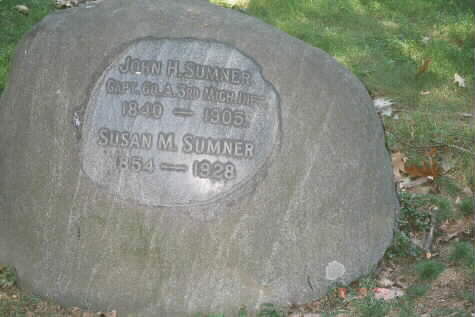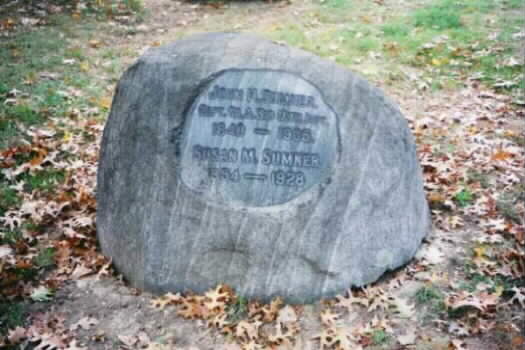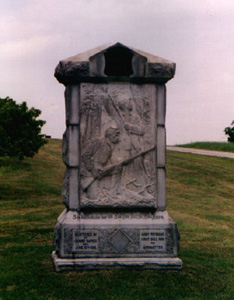Sumner, John H. Sumner, Captain, United States Army, Company A, 3rd Michigan Volunteer Infantry. Born in 1840 and died in 1905. Buried with full military honors in Section 3 of Arlington National Cemetery.
His wife, Susan M. Sumner, 1854-1928, is buried with him.

Courtesy of Steve Soper
Old Third Michigan Infantry Project
John H. Sumner was born in 1840 at Boston, Massachusetts, probably the son of
Samuel. John left Massachusetts and moved west, eventually settling in western
Michigan where by 1859-60 he was living with one Samuel Sumner (probably his
father) on the north side of Lyon east of Prospect street in Grand Rapids, Kent County, Michigan.
John stood 5¹6² with blue eyes, auburn hair and a light complexion and was a 21-year-old dentist possibly living in Grand Rapids or Zeeland, Ottawa county when he enlisted in Company A on May 13, 1861.
He was reported in the Brigade Commissary Department in July of 1862, and was promoted to Commissary Sergeant on August 1 or 17, 1862, at Harrison¹s Landing,
Virginia. In early March of 1863 John returned to his home in Grand Rapids
on a 20-day furlough, to visit his parents and friends in this city.” John soon returned to the Regiment and was awarded the Kearny Cross for his participation in the battle of Chancellorsville, Virginia, on May 3, 1863.
He was still Quartermaster Sergeant when he reenlisted on December 24, 1863, at Brandy Station, Virginia, crediting Cannon, Kent county, and presumably returned to his home in Michigan on veterans furlough in January of 1864; if so he probably returned to the Regiment on or about the first of February.
He was discharged per special order number 42 (dated February 19, 1864) in order to be promoted and commissioned as of December 31, 1863. John was subsequently promoted to Regimental Quartermaster on January 1, 1864, at Camp Bullock, Virginia, commissioned November 25, 1863, replacing Captain Robert M. Collins, who had been promoted to the U.S. Army regulars. John was mustered out with the regiment on June 20, 1864, at Detroit.
After leaving the Army John returned to Michigan where he reentered the service as Captain of Company A, Reorganized Third Michigan infantry on July 29, 1864, at the organization of that unit, in Grand Rapids. Charles Wright, formerly Company A, wrote home on December 5, 1864, from Petersburg, Virginia, “.. that I heard from the new Third the other day. They were down in Georgia and had been in a four day fight, and lost five men out of the Regiment in killed and wounded. With two exceptions that Regiment has a lot of cowards for officers, Lieutenant Moon, formerly sergeant of my company is not one of them nor is John Sumner captain of that Regiment.”
On January 21, 1865, Sumner requested a leave of absence. I have the honor, he wrote to Brigadier General W. D. Whipple, “to make application for a leave of absence for (20) twenty days, to visit my home in Michigan. I have now entered upon my second term of service for three years. On being mustered out of the United States service, I held the position of R.Q.M. Third Michigan Veterans Infantry; my Regiment was consolidated with the 5th Michigan Veteran Infantry, and my business was left in an unsettled condition, which must have serious injury to the officers of the Regiment so consolidated, unless I can properly settle my business connected with the Regiment to which I formerly belonged. I have made stringent efforts through the Mail to do so, but have thus far failed. I know now of no way in which it can be done without my personal presence and attention. At the evacuation of Decatur, Alabama, November 25th, 1864, I lost my valise, containing my uniform and other clothing. I wish to purchase another Uniform and outfit, which I am unable to procure here.”
John’s request was granted and he was absent with leave from February 6. By the second week of February was back home in Grand Rapids. Captain John Sumner, wrote the Eagle on February 9, ” .. of the new Third Michigan infantry, has just returned from the front, on a short furlough, to visit his parents and friends in this city. He reports the boys in his command and Regiment generally well and in good spirits.”
He eventually rejoined the Regiment and was tried by a general court martial at New Orleans, Louisiana on July 4, 1865, for disobedience of orders (specifics unknown). He was found guilty and fined forfeiture of one month pay. He was Acting Commissary and Subsistence at Victoria, Texas from November 28, 1865, through April of 1866, and was mustered out with the Regiment on May 25, 1866 at Victoria, Texas.
After the war John returned to Grand Rapids and was probably living at 137 Lyon street in 1865-66. He worked in the bookkeeping department of the Grand Rapids Democrat from 1870 until 1872 when he became engaged in selling real estate in Grand Rapids. On December 13 the Democrat wrote that “Sumner along with one E. L. Somers opened a real estate office and collection agency, with Alfred Putnam, Justice of the Peace. These gentlemen are young, active, experienced in business, and are sure to succeed. For two years past, Mr. Sumner has been employed in the counting room of the Democrat, and during that time has acquitted himself to the satisfaction of his employers, proving faithful to every tract and energetic in the discharge of his duties. His associate, Mr. Somers, is widely known and generally respected, as a man of integrity, and sound judgment, who never allows pleasure to stand in the way of business. We wish the firm the greatest success.”
He was married to Susan (1854-1928) and had at least one child, a daughter. In politics John was a staunch Democrat, and he was a member of the Old Third Michigan Infantry Association.
John resided in Grand Rapids for some years but by 1900 he had moved to Washington, DC, where he was working as Second Assistant Postmaster in the
U.S. Post Office. He died at his home in Washington on May 2, 1905, and was
buried in Arlington National Cemetery, Section 3, Grave 1515.
Michael Robert Patterson was born in Arlington and is the son of a former officer of the US Army. So it was no wonder that sooner or later his interests drew him to American history and especially to American military history. Many of his articles can be found on renowned portals like the New York Times, Washingtonpost or Wikipedia.
Reviewed by: Michael Howard


